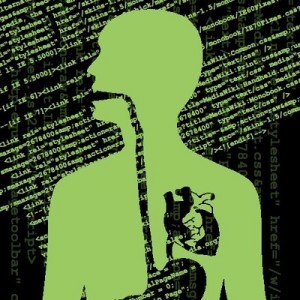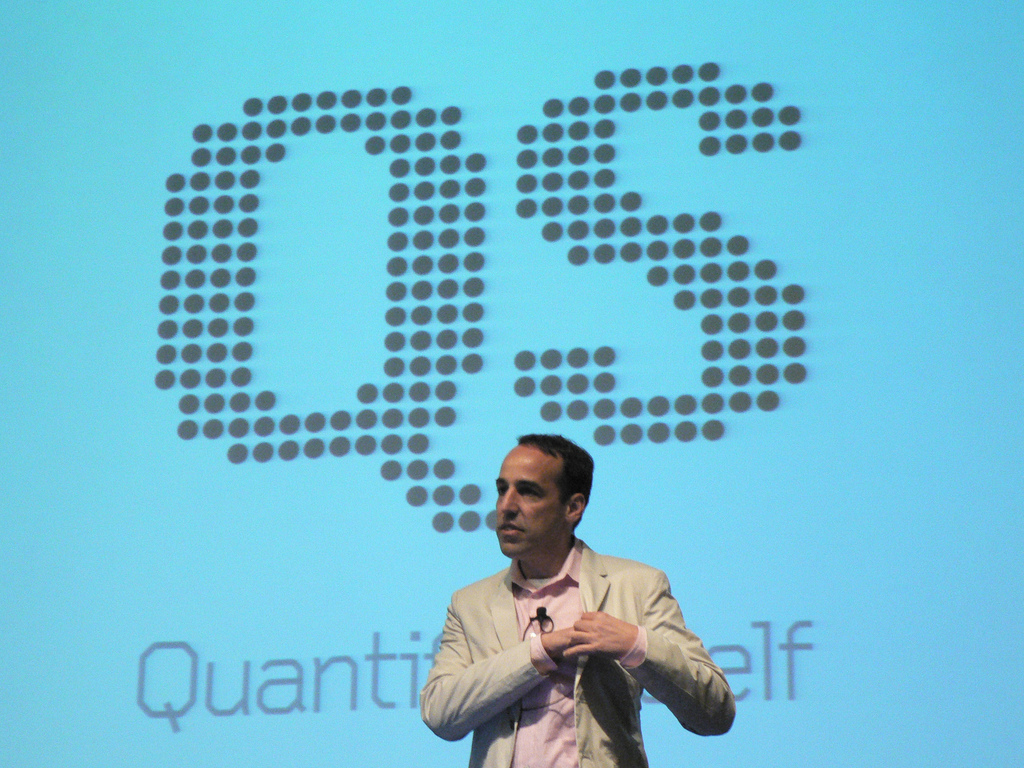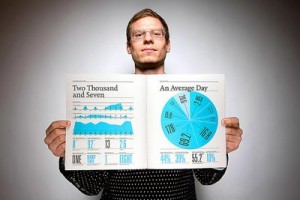In preparation for the 2012 Quantified Self Conference on 15 and 16 September (#QS2012), I’ll be spending the next two weeks writing about the “self knowledge through numbers” group Quantified Self (@QuantifiedSelf). This week, I focus on self-quantification in relation to my masters work on what I’ve termed biomedicalization 2.0; next week I’ll focus on my upcoming dissertation project, which will look specifically at emotional self-quantification (or “mood tracking”).
What is biomedicalization 2.0?
In 2003, Clarke, Shim, Mamo, Fosket, and Fishman [paywall, sorry] proposed biomedicalization as a way to describe “the increasingly complex, multisited, multidirectional processes of medicalization, both extended and reconstituted through the new social forms of highly technoscientific biomedicine.” Beginning around 1985, and against the backdrop of late modernity, biomedicalization emerged as technoscience was increasingly incorporated into medicine. This incorporation changed not only the practice of medicine, but also the process of medicalization. Biomedicalization furthered the expansion of medical authority into more areas of human life, and reorganized the institution of biomedicine “from the inside out.”
In 2012, against the backdrop of ‘the digital age’, ‘the post-genomic era’, a ‘post-privacy world’, and a ‘postindustrial society,’ I argue that we are seeing the emergence of a new form of biomedicalization, one that I wryly term biomedicalization 2.0. With “biomedicalization,” I reference Clarke et al’s theory of biomedicalization and signal the ways this new form mirrors and extends the process of biomedicalization. With “2.0,” I reference the technical convention for distinguishing a new version from its predecessor, as well as the emphasis on ‘a new paradigm’ that characterized the much-hyped announcement of ‘Web 2.0’ in 2004. Biomedicalization emerged from the coalescence of major technoscientific changes within the medical sphere[i]; biomedicalization 2.0 is similarly emerging as recent technoscientific innovations converge with venture capitalism, technoutopian cyberculture, and the digital economy at sites outside of biomedicine’s jurisdiction. Where medicalization and biomedicalization extend the range of medical authority by extending the range of medical practice, biomedicalization 2.0 challenges medical authority through ‘medical’ practices that have been resituated in contexts outside of institutional medicine’s oversight and control.
I use the term extramedical to describe those areas which remain outside of institutional biomedicine’s expanded and expanding authority, and I argue that the convergences described above constitute an amorphous, decentralized extramedical sphere. I further argue that the institutions and individuals within the extramedical sphere expand the extramedical domain by claiming authority within territories of knowledge and practice previously claimed for the exclusive medical domain. Extramedical expansion is inclusive rather than exclusive, however, and aims not to supplant the medical sphere as sovereign within claimed territories, but to replace state-supported sovereignty with ‘free market competition’ by removing claimed territories from the medical domain altogether. By claiming ‘medical’ territories as ‘not-medical,’ extramedical actors bring the very meaning of the word “medical” into question. These jurisdictional and semantic-taxonomic challenges have the potential to disrupt the organization of institutional biomedicine once again, not “from the inside out,” but from the outside in.
Below I offer a basic crash-course for readers who may not be familiar with sociological work on medicalization and biomedicalization, then elaborate on biomedicalization 2.0 by considering the Quantified Self groups as an example of biomedicalization 2.0 in action.

So what are medicalization and biomedicalization?
Sociologists use the term medicalization to describe both the increased investment in institutional medicine (or the medical industrial complex) that began in the years following World War II, and also the related phenomenon by which medicine and medical labels (such as “healthy” and “ill”) become newly applicable to more areas of human life. Most generally, medicalization represents the expansion of medical authority through the claiming of new things as medical events or medical problems: some classic examples are birth and death (which used to be ‘natural life processes’ that happened at home, but which now typically happen in hospitals and with medical intervention), or alcoholism and other addictions (which used to be seen as character flaws, but which are now largely recognized as ‘diseases’ instead).
It’s important to note, however, that this expansion isn’t uniform. Ehrenreich and Ehrenreich identify the expansion of medical authority and control as cooptative medicalization, one of medicalization’s two dual tendencies; the other is exclusionary medicalization, the process by which access to and quality of available healthcare is stratified according to patients’ abilities to pay. Medicalization brings more areas of human life into institutional medicine’s control, but it also excludes more individual humans from the newest services and interventions.
 Biomedicalization is Clarke et al’s term to describe a process that began around 1985, and that changed the character both of institutional medicine and of medicalization. What happened is that interrelated technological developments and social changes that had been accumulating over the course of medicalization reached a kind of critical mass, and transformed institutional medicine (or biomedicine) “from the inside out.” Transformation is a key theme within biomedicalization, as new technoscientific innovations enable the practice of medicine, the institutional organization of healthcare, and individual human bodies to be altered and metamorphosed in ways that would have been unimaginable even a generation ago.
Biomedicalization is Clarke et al’s term to describe a process that began around 1985, and that changed the character both of institutional medicine and of medicalization. What happened is that interrelated technological developments and social changes that had been accumulating over the course of medicalization reached a kind of critical mass, and transformed institutional medicine (or biomedicine) “from the inside out.” Transformation is a key theme within biomedicalization, as new technoscientific innovations enable the practice of medicine, the institutional organization of healthcare, and individual human bodies to be altered and metamorphosed in ways that would have been unimaginable even a generation ago.
Clarke et al emphasize that biomedicalization has not fully replaced medicalization—the two processes can and do occur in the same places and at the same times—but biomedicalization does represent a transformation of medicalization. Put very simply, biomedicalization continues to expand institutional medicine’s authority even further (particularly by claiming “health” as a site of medical intervention in addition to “illness”), but 1) the institution of medicine is changed (think individual doctor’s offices vs. the giant bureaucracy of an HMO), and 2) the process occurs in a wider variety of ways (for one example, think of your doctor telling you to lose weight vs. your friends trying to recruit you into doing a new fad diet with them).
Some of the major changes in biomedicalization involve issues of power and expertise. In biomedicalization, physicians and academic researchers find their influence and authority not only supplanted by corporations within the medical sphere, but also increasingly contested by patients and other lay individuals within the medical domain. Though patient advocacy groups first began to form in the 1970s, the advent of the Internet has enabled more lay individuals both to access an expanded array of previously restricted medical knowledges and to network and organize with each other. The number of support and advocacy groups has since expanded greatly, and a number of such groups are sufficiently powerful to lobby for changes in federal policy and to direct specific research projects through funding initiatives.
Not all of the changes within biomedicalization have empowered lay individuals, however. As patient groups gained political and economic power, agents within the medical sphere (such as pharmaceutical companies, physician organizations, and researchers) began to form their own ‘grassroots’ patients’ movements – which are sometimes called “Astroturf movements” by critics – in order to capitalize on a new avenue of influence. The increase in patients’ demands for more egalitarian and collaborative relationships with their physicians also fits synergistically with the ongoing devolution of healthcare, in which responsibility for much of the monitoring and care-giving labor of medical care is shifted from healthcare professionals to patients’ families or to patients themselves. Is this ‘empowerment,’ or something more like exploitation? Who benefits (and how) when patients “take more responsibility” for their health and healthcare?

What is the Quantified Self?
The Quantified Self exemplifies one of the things that I find most fascinating within biomedicalization 2.0, which is what I term chiasmata: unsettled and unsettling—yet potentially productive—relationships within the new blurred, hybridized, and seemingly contradictory concepts and identities that emerge within the extramedical sphere. I’m borrowing heavily here from Fortun’s Promising Genomics, in which he uses X, the chiasmus, to mark “couplet[s] of terms which are conventionally taken as distinct or even opposed, but that in fact depend on each other, provoke each other, or depend on each other.” I use the term chiastic identities to describe the similarly uneasy, unsettled, troubling-yet-promising relationships within new blurred and hybridized forms of subjecthood such as subjectXresearcher and subjectXconsumer. Though blurred conceptual boundaries (such as those between labor and recreation, or between production and consumption) are characteristic of postindustrial societies most generally, the chiastic identities of biomedicalization 2.0 both embody and reflect the tensions inherent in medicalization, biomedicalization, and biomedicalization 2.0, and pose questions that are not easily answered.
Self-quantifiers (or self-trackers) are subjectsXresearchers because they are both the observers and the observed in their studies of n=1; they simultaneously occupy both positions in what is usually a relationship of unequal power, and in so doing conflate conceptual binaries around empowerment, agency, and exploitation. Although some people self-track at a doctor’s behest, and under a doctor’s supervision, others do so independently, or interact with doctors only as hired consultants rather than as authority figures; in this way, they challenge both traditional medical authority and the traditional doctor-patient power relationship.
Can self-directed self-tracking represent the potential for individuals to “take more responsibility” for their health in ways that might more closely resemble empowerment, rather than the devolution of healthcare? Before we can answer these questions, we have to decide what ‘empowerment’ really means (for whom, and in which contexts, and who decides?); we also need to ask who benefits, and how, when individuals are asked to “take more responsibility” for anything, or to focus on personalized rather than collective action as the path to “empowerment.” (I hope to take on some of these questions in my dissertation project, which I’ll talk more about next week.)

Co-founded by Gary Wolf (@agaricus) and Kevin Kelly (@kevin2kelly), the Quantified Self is one of the largest groups of networked subjectsXresearchers. Though started in the Bay Area in 2007, it gained national attention in 2010 following Wolf’s New York Times Magazine article on “the data-driven life.” Wolf’s essay is a common (though not universally representative) narrative of self-tracking, one in which the archetypal self-tracker is indisputably an autonomous individual. In keeping with the technoutopian heterodoxy’s distrust of authority and traditional institutions, and in accordance with the extramedical sphere’s challenges to medical authority in particular, the self-tracker resists being controlled (and possibly harmed) by institutional biomedicine in part simply by refusing to follow medical advice.
The self-tracker is empowered to make this refusal not just by information, however, but by quantified self-knowledge: though his doctor may be the ‘expert’ on matters of medicine-most-generally, through technology-enabled observation and detailed, quantified records, the self-tracker is certain of being the expert on himself (I say “himself” here because the majority of self-trackers mentioned in the essay are men). Moreover, this refusal to accept medical authority is an act not just of self-preservation, but also of self-defense and political defiance in the face of “the imposed generalities of official knowledge.” The self-tracking subjectXresearcher is The Individual taking on The Establishment, one datum at a time.
Self-tracking, however, is not just an exercise in defying medical authority. The self-tracking subjectXresearcher also takes neoliberalism’s preoccupation with The Individual and turns it inward, onto his own individual self. While Quantified Self founders point to the benefits that self-tracking can have on both self-awareness and on relationships with others, these immediate personal relationships seem to be the blurry edge of a quantified field of vision. Even the self-tracker’s characteristic defiance of institutional biomedicine, it turns out, is less about rebellion or revolution; rather, it “shows how closely the dream of a quantified self resembles therapeutic ideas of self-actualization.” The self-empowerment of self-quantifying, it seems, has less to do with the individual in the world and more to do with the individual in his own interiority; it may be less about challenging older relationships of authority and expertise, and more about coming to terms with the world as it stands.
The archetypal self-tracker who emerges from the vignettes in Wolf’s essay does not, of course, represent all self-trackers, or even all self-trackers who are Quantified Self members. Yet, this un/intentionally polemicized figure of the subjectXresearcher highlights a different facet of biomedicalization 2.0: the ways in which preoccupation with ‘information’ and individual self-hood can potentially create subjects who are not empowered, but disengaged. This version of the self-tracking subjectXresearcher, pacified by the steady stream of information generated through daily practices, may get absorbed into the digitized abstraction of his own quantified identity. Is self-quantification a way to change the world, or a way to make peace with the world-as-it-stands? Can self-tracking individuals change the world if they all self-track together? I don’t yet have answers to these questions, nor do I think anyone else does.
Next week I’ll talk more about some of these issues, particularly as they relate to mood tracking and my dissertation project.
Whitney Erin Boesel (@phenatypical) will be at #QS2012 later this month. Come say hi!
Quantified pair image from http://onpoint.wbur.org/2012/04/26/the-data-driven-life
Digesting code image from http://soundcloud.com/chgrasse/quantified-self-feature
Semi-abandoned hospital image from http://sejin7940.com/secret-camera/secret-camerasamsung-f480-mobile-phone-secret-codes/
Gary Wolf at #QS2011 photo by Marc Smith (@marc_smith) from http://www.netzpiloten.de/2012/01/30/the-quantified-self-in-heatlh-an-lifestyle/
Self-quantification chart photo from http://techish.tumblr.com/post/27049469332/self-tracking-as-a-dialogue-between-the-virtual-and
[i] I use “the medical sphere” to denote the organizations, corporations, and individuals involved in or connected to the practice of institutional (bio)medicine, such as health management organizations (HMOs), pharmaceutical companies, physician organizations, academic research centers, healthcare and research professionals, etc. I use “the medical domain” to describe the realm of institutional (bio)medicine’s jurisdiction, and the areas within that realm over which institutional (bio)medicine claims exclusive authority (such as the diagnosis and treatment of disease, the manufacturing and prescribing of pharmaceuticals, the production and management of knowledges about the human body, etc.)

Comments 16
Doug Hill — September 7, 2012
Excellent primer. Thank you.
Gary Wolf — September 7, 2012
Thank you for this essay. I thought it might be useful to our short exchange on Twitter to the comments here. To me your description of the ambiguity around certain themes in QS is very relevant. I'd like to continue this conversation at the conference, but perhaps will challenge some of the assumptions implicit in the framework you're using. The caricature of the disengaged and pacified self-tracker who mistakes abstract autonomy for real freedom, and thus fails to participate in revolutionary action to change the world, is hard for me to credit. One difficulty, for me, is that there is no alternate universe in which we are differently empowered, against which our current failings can be clearly seen. Show me the revolution that we're missing! By using these tools and talking about them, we are attempting to _find_ their meaning, we are arguing over their usefulness, and making our case through example. That includes examples of things that don't work as well as examples of discoveries and pleasures. I think of QS as part of a family of practices emerging at a time when our ways of understanding and asserting ourselves - both individually and in our communities - aren't easily described by concepts like liberal, revolutionary, or reactionary. So I think the ambiguity you describe is evident, and hope our discussion will lead to more ways to describe it.
Deborah Lupton — September 9, 2012
Thanks for introducing me to the Quantified Self concept - fascinating. I have been writing about the use of digital technologies for health promotion: see http://www.palgrave-journals.com/sth/journal/v10/n3/abs/sth20126a.html for an academic article on this and a blog post here: http://simplysociology.wordpress.com/2012/06/20/the-new-mobile-digital-technologies-health-and-the-body/. I am also interested in how these technologies operate to reconfigure concepts of health and embodiment.
What We Are Reading | Quantified Self — September 10, 2012
[...] Empowerment Through Numbers: Biomedicalization and The Quantified Self In this interesting post from the Cyborgology blog, sociologist Whitney Erin Boesel describes some important ambiguities in the Quantified Self movement. How empowering is it, really? Whitney will be at the conference and invites comment and discussion. [...]
Empowerment Through Numbers? Biomedicalization 2.0 and the ... | Wearable tech and biosensors for learning | Scoop.it — September 11, 2012
[...] In preparation for the 2012 Quantified Self Conference on 15 and 16 September (#QS2012), I'll be spending the next two weeks writing about the “self knowledge through numbers” group Quantified Self (@QuantifiedSelf). [...]
Empowerment without Independence » Cyborgology — September 11, 2012
[...] week Sarah Wanenchak (@dynamicsymmetry) and Whitney Erin Boesel (@phenatypical) separately broached the tensions between technologies, bodies, ownership, and [...]
Für meine Bachelorarbeit in Berlin – Eindrücke vom 4. Quantified Self Meetup in der c-base | vermessen leben — September 11, 2012
[...] Ist Quantified Self eine sich neu-entwickelnde Therapieform für Alternativen-Suchende? Eine Flucht in Zahlen, statt in Medikamente oder in klassisch psychotherapeutische Ansätze? Sich selber helfen mit Quantified Self? Doch biomedicalization 2.0? [...]
Empowerment Through Numbers? Biomedicalization 2.0 and the Quantified Self | Flash Politics & Society News | Scoop.it — September 12, 2012
[...] In preparation for the 2012 Quantified Self Conference on 15 and 16 September (#QS2012), I’ll be spending the next two weeks writing about the “self knowledge through numbers” group Quantified Self (@QuantifiedSelf). [...]
Meaning-Making Through Numbers: Emotional Self-Quantification » Cyborgology — September 13, 2012
[...] Last week, I focused on self-quantification in relation to my masters work on what I’ve termed biomedicalization 2.0; this week, I focus on my upcoming dissertation project, which will look specifically at emotional [...]
Empowerment Through Numbers? Biomedicalization 2.0 and the Quantified Self | healthcare technology | Scoop.it — September 17, 2012
[...] What is biomedicalization 2.0? In 2003, Clarke, Shim, Mamo, Fosket, and Fishman [paywall, sorry] proposed biomedicalization as a way to describe “the increasingly complex, multisited, multidirectional processes of medicalization, both extended and reconstituted through the new social forms of highly technoscientific biomedicine.” Beginning around 1985, and against the backdrop of late modernity, biomedicalization emerged as technoscience was increasingly incorporated into medicine. This incorporation changed not only the practice of medicine, but also the process of medicalization. Biomedicalization furthered the expansion of medical authority into more areas of human life, and reorganized the institution of biomedicine “from the inside out.” [...]
Empowerment Through Numbers? Biomedicalization 2.0 and the Quantified Self » Cyborgology | The Sociology of the Quantified Self | Scoop.it — September 29, 2012
[...] [...]
Empowerment Through Numbers? Biomedicalization 2.0 and the Quantified Self » Cyborgology | Cultural Studies | Scoop.it — September 29, 2012
[...] [...]
Empowerment Through Numbers? Biomedicalization 2.0 and the Quantified Self » Cyborgology | DigitAG& journal | Scoop.it — October 2, 2012
[...] [...]
Measured Me Awesome Links Weekly Roundup | Measured Me — November 30, 2012
[...] + biomedicalization + Quantified Self = Cyborgology: a thought-provoking article in The Society [...]
Self-Tracking: A Low-Tech Practice » Cyborgology — February 5, 2013
[...] We all know that Cyborgologist Whitney Erin Boesel (@phenatypical) is our resident expert on self-tracking however, as she makes her way from one side of the country to the other, I will pick up the [...]
What is the Quantified Self Now? » Cyborgology — May 23, 2013
[...] testing, “citizen science,” and the DIY Bio movement as part of my work on what I’ve termed biomedicalization 2.0. For a while thereafter, whenever I heard “quantified” and “self” together, it was usually [...]